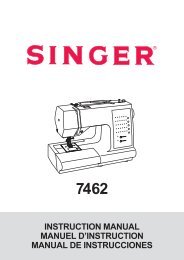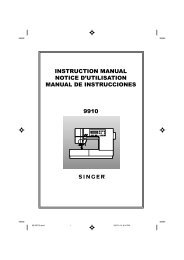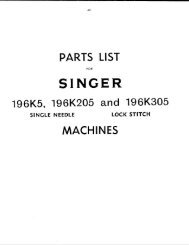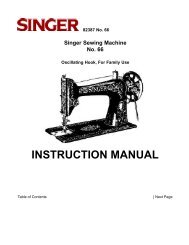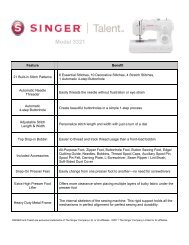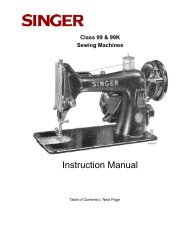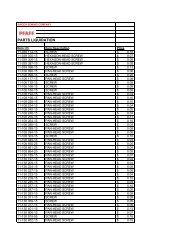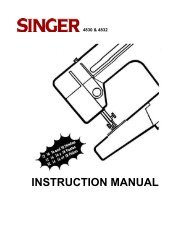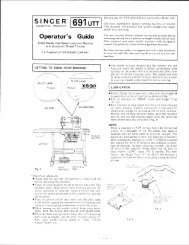Instruction Book Libro de Instrucciones Livret d'Instructions ... - Singer
Instruction Book Libro de Instrucciones Livret d'Instructions ... - Singer
Instruction Book Libro de Instrucciones Livret d'Instructions ... - Singer
You also want an ePaper? Increase the reach of your titles
YUMPU automatically turns print PDFs into web optimized ePapers that Google loves.
7<br />
Fabric handling, when sewing tubular and hard<br />
reach garment areas, is simplified and ma<strong>de</strong><br />
easier when you use the free-arm sewing<br />
capability of your sewing machine.<br />
Sleeves<br />
Free-arm sewing takes the difficulty out of<br />
topstitching, sleeves, finishing waistbands<br />
and trouser legs rotate smoothly un<strong>de</strong>r the<br />
needle, around the arm, allowing you toplace<br />
your stitching accurately.<br />
Buttons<br />
Sewing buttons on a cuff or neckband is easy<br />
with free-arm sewing. The sewing arm allows<br />
room for cuffs to slip onto without being<br />
stretched out of shape, and you can also see<br />
and handle the stitching area more easily.<br />
Bar tacks<br />
Free-arm<br />
sewing<br />
Bar tacks reinforce areas of strain and can be<br />
applied to ready-ma<strong>de</strong> garments, as well as<br />
to those sewn at home. Use the free-arm<br />
surface to avoid fabric bulk around the needle<br />
when you apply bar tacks to pockets, pleats<br />
and waistlines.<br />
Costura con<br />
base libre<br />
El manejo <strong>de</strong> los tejidos, al coser en circular o<br />
áreas <strong>de</strong> acceso dificil, se simplifica y resulta<br />
más facil, cuando utiliza la ventaja <strong>de</strong> costura<br />
con base libre <strong>de</strong> que dispone su máquina para<br />
coser.<br />
Mangas<br />
La costura con base libre evita las dificulta<strong>de</strong>s<br />
que se presentan al realizar puntadas<br />
superiores, coser mangas,acabado <strong>de</strong><br />
cinturas y áreas dificiles en pantalones, ya<br />
que al rotar por <strong>de</strong>bajo <strong>de</strong> la aguja y alre<strong>de</strong>dor<br />
<strong>de</strong> la base, le permite realizar su costura con<br />
precisión.<br />
Botones<br />
El coser botones sobre un puño o cuello es<br />
mucho más facil con la base libre. La base <strong>de</strong><br />
costura tiene capacidad para que los puños<br />
<strong>de</strong> <strong>de</strong>slicen sin necesidad <strong>de</strong> estirarlos o<br />
<strong>de</strong>formalos, al tiempo que pue<strong>de</strong> verificar y<br />
manejar con mayor facilidad el área <strong>de</strong><br />
costura.<br />
Presillas<br />
Las presillas refuerzan las áreas <strong>de</strong> tirantez y<br />
pue<strong>de</strong>n aplicarse a prendas confeccionadas,<br />
así como a aquellas costuras <strong>de</strong>l hogar.<br />
Utilice la superficie <strong>de</strong> la base libre para evitar<br />
que el tejido se arruge alre<strong>de</strong>dor <strong>de</strong> la aguja<br />
cuando aplica presillas a los bolsillos,<br />
aberturas y cinturas.<br />
Devanado <strong>de</strong> una bobina<br />
Devanar una bobina es rápido y fácil cuando se siguen las directrices abajo indicadas.<br />
Siempre <strong>de</strong>vane la bobina antes <strong>de</strong> enhebrar la máquina y la aguja.<br />
Presione hacia a<strong>de</strong>ntro el disco (1) <strong>de</strong>l volante. Esto impedirá el movimiento <strong>de</strong> la aguja.<br />
Coloque el carrete <strong>de</strong> hilo en su eje.<br />
Inserte el tope (2) firmemente contra el carrete para impedir que se enre<strong>de</strong> el hilo.<br />
Guíe el hilo <strong>de</strong>l carrete e insértelo en la guía (3).<br />
Bobine el hilo en el sentido <strong>de</strong> las agujas <strong>de</strong>l reloj alre<strong>de</strong>dor <strong>de</strong>l disco <strong>de</strong> tensión (4).<br />
Pase el cabo <strong>de</strong>s<strong>de</strong> <strong>de</strong>ntro por el pequeño agujero <strong>de</strong>l bor<strong>de</strong> <strong>de</strong> la bobina.<br />
Coloque la bobina en su eje y empújelo hacia la <strong>de</strong>recha.<br />
Sujetando el cabo, presione el controlador <strong>de</strong> velocidad hasta tener la cantidad <strong>de</strong> hilo <strong>de</strong>seada en<br />
la bobina (el bobinado se <strong>de</strong>tiene automáticamente al llenarse la bobina).<br />
Corte el hilo, empuje la bobina hacia la izquierda y sáquela <strong>de</strong> su eje.<br />
Corte el cabo inicial <strong>de</strong>l hilo <strong>de</strong> la bobina.<br />
Ajuste el volante a la posición <strong>de</strong> costura presionando el botón <strong>de</strong> forma opuesta.<br />
Remplissage <strong>de</strong> la canette<br />
En suivant les conseils ci-<strong>de</strong>ssous, il est facile <strong>de</strong> remplir une canette. Confectionnez toujours la<br />
canette avant d’enfiler la machine.<br />
Appuyez sur la pentelure <strong>de</strong> débrayage (1) pour arrêter le mouvement <strong>de</strong> l’aiguille.<br />
Mettez en place la bobine <strong>de</strong> fil sur le porte-bobine.<br />
Bloquez la bobine à l’ai<strong>de</strong> <strong>de</strong> l’étrier (2) pour éviter que le fil s’emmêle.<br />
Tirez le fil et enclenchez-le dans le gui<strong>de</strong>-fil (3).<br />
Passez le fil entre les disques <strong>de</strong> tension du dévidoir (4) en le croisant dans le sens montré par les<br />
flèches.<br />
Passez l’extrémité du fil à travers un <strong>de</strong>s trous <strong>de</strong> la canette, <strong>de</strong> l’intérieur vers l’extérieur.<br />
Engagez la canette sur le support du dévidoir et poussez-la vers la droite.<br />
Tenez l’extrémité du fil, appuyez sur le rhéostat. Remplissez la canette avec la quantité <strong>de</strong> fil désiré.<br />
(Le remplissage s’arrêtera automatiquement quand la canette sera pleine).<br />
Coupez le fil et repoussez l’axe du dévidoir vers la gauche avant <strong>de</strong> retirer la canette.<br />
Coupez l’extrémité du fil sur le <strong>de</strong>ssus <strong>de</strong> la canette.<br />
Remettez en place le disque <strong>de</strong> débrayage en appuyant sur le côté opposé au sigle.<br />
70 19



